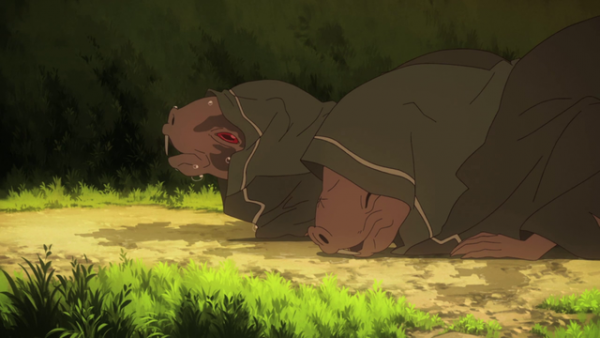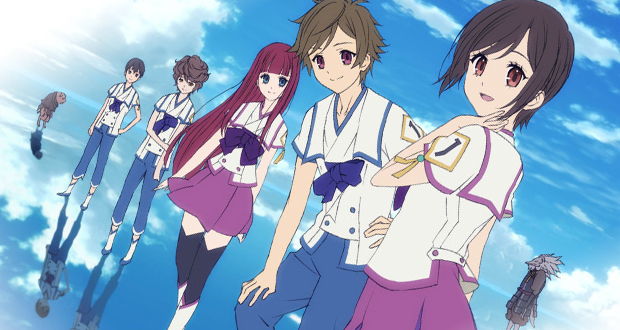Tying Together Dvořák, Goin’ Home, and Shinsekai Yori
It was a recent episode of Sound! Euphonium that made me think of Shinsekai Yori. Not because there were any plot parallels, though it would be hilarious to see Kyoto Animation do an anime as dark as Shinsekai Yori. Rather, it was the music, particularly the scene in which Euphonium‘s Reina plays the second movement of Dvořák’s From the New World Symphony. So before we go on, here’s the New World Symphony, performed by the Royal Philharmonic Orchestra, conducted by Paavo Järvi:
The New World Symphony is superb, especially the second movement which stands as a sharp contrast to the other movements. The first movement is moody, the third movement is energetic, and the last movement delivers a grim march for its grand finale. Comparatively, the second movement is peaceful and bucolic. The serene English horn melody carries melancholy undertones akin to those found in Negro spirituals, religious songs that also told of the hardships African-Americans experienced as slaves. Dvořák drew inspiration from Negro spirituals and incorporated their tonal elements into the Symphony.
Beyond the structure of the symphony itself, the second movement can function as a standalone piece. One of Dvořák’s students, William Fisher, took the melody, wrote some lyrics for it, and gave this hymn a title: “Goin’ Home”. Its lyrics speak of “fearing no more” by returning to the safety of family and friends and expands upon that by talking about the joys of the next daybreak, as restless dreams and shadows disappear with the dawn. Those sentiments are lovely and match up closely with the world of Shinsekai Yori. (Spoilers ahead)
In Shinsekai Yori, you’ll hear the second movement of the New World Symphony sound out just before sunset to summon the children home where they’re safe from the dangerous creatures that live beyond the village’s magic barrier. So when you take the lyrics to “Goin’ Home” and the and combine it with the situational context, the implementation makes a lot of sense.
But the anime title, Shinsekai Yori, which translates to “From the New World”, is more than just a passing reference to the use of the second movement. Rather, it captures the totality of the anime’s world history and speaks to the main influence that Dvořák incorporated into the Symphony: the Negro spiritual.
For one, Shinsekai Yori‘s world began to unravel once a small population of humans developed psychic abilities. This rift led to a bloody history, one that only stabilized once the psychic humans were able to engineer themselves incapable of killing other humans. Humans who didn’t have psychic powers became second-class citizens and were subject to genetic experiments so that they could be controlled. Their DNA would be spliced along with that of the mole rats, creating the Monster Rats that inhabited the world of Shinsekai Yori and were generally subservient to humans.

The subservient monster rat and the African experience under slavery aren’t altogether too different a concept (with the former bringing to mind the infamous Tuskegee Experiments). Take that connection a step further and you find that Dvořák’s New World Symphony‘s Negro spiritual influences, with its exhortations for freedom, are used by the psychic humans but are more applicable to the monster rat’s situation.
This yearning for freedom from the psychic humans motivated Squealer and his colony of monster rats in their eventual failed uprising against the humans. His vehement, resentful cry that monster rats are people too resounded across Shinsekai Yori‘s powerful finale. In doing so, the bonds that tied Dvořák’s New World Symphony to its namesake anime would be complete, laid bare for all to see and hear.


Really, thanks a bunch for making me listen to the full symphony, had it on loop for the whole week! 😀
I had only heard parts of it before (it is pretty famous!) but I never noticed how great the horn theme in the first movement sounded. It is probably my favorite part of all this, above even the serene sounds of the second movement.
I’d be hard-pressed to choose between the first movement and the 4th movement. The horn theme in the first is pretty magnificent like you say and the foreboding melody in the 4th sends out this air of righteous doom that is utterly irresistible. Dvorak’s never really steered me wrong in terms of his compositions, so if you need any recommendations on stuff to check out, let me know!
Thanks! I’d actually love to have quick posts about what you guys listen to. Not reviews, mind you, I really appreciate reading them but I know they take a lot of time to write. Just things like “oh, this week I’ve been listening to X, try it out”. I’m pretty sure there is a lot of great music I could discover that way. Oh, but maybe Twitter’s better for this kind of things?
I also noticed you started recording a podcast and wanted to ask : is there a way you could post the audio files? YouTube’s great, but not really handy when it comes to listening to things in the subway without an internet connection…
Definitely a use case that didn’t come to mind. I’ll be sure to post an actual link to the mp3 file. And yeah, that’s a nice idea! I might try to revive the musical musings series of posts that I did awhile back.
Oh yeah I really feel the need to comment on this…or rather share a story. When I first watched Shinsekai yori as it was airing, I was wholly unaware of Dvorak’s symphony From the New World and so it actually came as quite the surprise when at some point(very soon) after finished the series, by some coincidence, I happened to be at a performance of a local community college wind ensemble. It was their beginner band section that was playing the piece. Despite it being performed by the beginner’s band which was immensely far from the best live performance I have heard, I recognized the piece immediately, and I was literally overcome by feelings and emotions that I had felt while watching the show. I had heard the conductor mention the name before they started playing, “From the New World” but my mind did not put the two things together until hearing the opening notes. When I did finally put the pieces together, like I said, everything rushed onto me at once and I starting crying while listening to the piece. I doubt there has been many times in history when a beginner’s band played music sent an audience member to tears. I doubt they even knew what they caused in me. But to this day I can clearly remember that moment and cannot think of Shinsekai yori without thinking of it. It was quite an experience and raised the bar of a show I had already been entertained by to an even further level.
Sometimes, the emotional power of music rises when paired with good context. It certainly helps that the anime is as good as it was in bringing out the emotional depth of the tragedies the characters experienced. You are right in that the anime and the Dvorak work really well in tandem with each other, and the results are beautiful!
Pingback:Ranking 12 Times Dvorak’s New World Symphony was Used in Anime – The Moyatorium